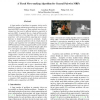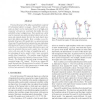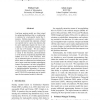204
click to vote
CVPR
2012
IEEE
13 years 3 months ago
2012
IEEE
A large number of problems in computer vision can be modeled as energy minimization problems in a markov random field (MRF) framework. Many methods have been developed over the y...
126
click to vote
CVPR
2012
IEEE
13 years 3 months ago
2012
IEEE
Pictorial Structures (PS) define a probabilistic model of 2D articulated objects in images. Typical PS models assume an object can be represented by a set of rigid parts connecte...
140
click to vote
CORR
2012
Springer
13 years 8 months ago
2012
Springer
We address the problem of learning the parameters in graphical models when inference is intractable. A common strategy in this case is to replace the partition function with its B...
149
Voted
CORR
2012
Springer
13 years 8 months ago
2012
Springer
Compiling Bayesian networks (BNs) to junction trees and performing belief propagation over them is among the most prominent approaches to computing posteriors in BNs. However, bel...
139
Voted
EMNLP
2011
14 years 12 days ago
2011
Log-linear parsing models are often trained by optimizing likelihood, but we would prefer to optimise for a task-specific metric like Fmeasure. Softmax-margin is a convex objecti...
139
click to vote
AAAI
2011
14 years 20 days ago
2011
Coarse-to-fine approaches use sequences of increasingly fine approximations to control the complexity of inference and learning. These techniques are often used in NLP and visio...
130
click to vote
AAAI
2011
14 years 20 days ago
2011
We present a dual decomposition approach to the treereweighted belief propagation objective. Each tree in the tree-reweighted bound yields one subproblem, which can be solved with...
132
click to vote
INFOCOM
2011
IEEE
14 years 4 months ago
2011
IEEE
—The multiple-access framework of ZigZag decoding [1] is a useful technique for combating interference via multiple repeated transmissions, and is known to be compatible with dis...
138
click to vote
CHI
2011
ACM
14 years 4 months ago
2011
ACM
Extracting useful knowledge from large network datasets has become a fundamental challenge in many domains, from scientific literature to social networks and the web. We introduc...
156
Voted
AI
2011
Springer
14 years 4 months ago
2011
Springer
Probabilistic inference in graphical models is a prevalent task in statistics and artificial intelligence. The ability to perform this inference task efficiently is critical in l...



